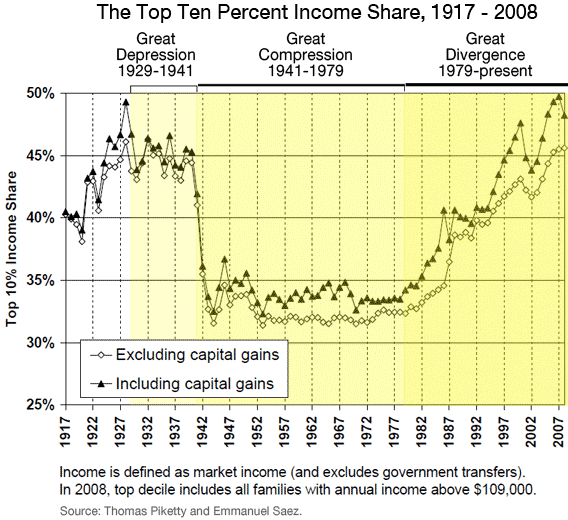New Series – “The Great Divergence”
Tim Noah at Slate has started a new series about income inequality called The Great Divergence. If you’ve read Paul Krugman’s Conscience of a Liberal you’re probably already aware of some of these issues. This series really puts it in a simple, easy to understand format.
Income inequality in the United States has not worsened steadily since 1915. It dropped a bit in the late teens, then started climbing again in the 1920s, reaching its peak just before the 1929 crash. The trend then reversed itself. Incomes started to become more equal in the 1930s and then became dramatically more equal in the 1940s. Income distribution remained roughly stable through the postwar economic boom of the 1950s and 1960s. Economic historians Claudia Goldin and Robert Margo have termed this midcentury era the “Great Compression.” The deep nostalgia for that period felt by the World War II generation—the era of Life magazine and the bowling league—reflects something more than mere sentimentality. Assuming you were white, not of draft age, and Christian, there probably was no better time to belong to America’s middle class.
The Great Compression ended in the 1970s. Wages stagnated, inflation raged, and by the decade’s end, income inequality had started to rise. Income inequality grew through the 1980s, slackened briefly at the end of the 1990s, and then resumed with a vengeance in the aughts. In his 2007 book The Conscience of a Liberal, the Nobel laureate, Princeton economist and New York Times columnist Paul Krugman labeled the post-1979 epoch the “Great Divergence.”
It’s generally understood that we live in a time of growing income inequality, but “the ordinary person is not really aware of how big it is,” Krugman told me. During the late 1980s and the late 1990s, the United States experienced two unprecedentedly long periods of sustained economic growth—the “seven fat years” and the ” long boom.” Yet from 1980 to 2005, more than 80 percent of total increase in Americans’ income went to the top 1 percent. Economic growth was more sluggish in the aughts, but the decade saw productivity increase by about 20 percent. Yet virtually none of the increase translated into wage growth at middle and lower incomes, an outcome that left many economists scratching their heads.
It’s generally understood that we live in a time of growing income inequality – I’m not sure people really understand this. I definitely don’t think politicians understand this. If Republicans really long for the 1950s why are they pursuing the policies of the 1920s? If you look at this graph I think you’ll see why a lot of us on the left think Reagan worship is overblown.
And all those countries that conservatives complain about? Most of them are showing rising equality, not decreasing. One more graph, just to show why people on the left laugh when we hear about “fiscal conservatives” and how Republicans support business.
It’s frustrating that we can’t have a discussion these days on what’s really happening to our country. Our middle class is being gutted and too many people argue for policies that continue to do this. The Koch brothers have convinced too many “regular” Americans that this is a good thing.
Tags: Economy, Income Inequality




“Income distribution remained roughly stable through the postwar economic boom of the 1950s and 1960s. Economic historians Claudia Goldin and Robert Margo have termed this midcentury era the “Great Compression.” The deep nostalgia for that period felt by the World War II generation—the era of Life magazine and the bowling league—reflects something more than mere sentimentality. Assuming you were white, not of draft age, and Christian, there probably was no better time to belong to America’s middle class.”
I strongly relate to this “Great Compression” period, since it provided a period of great opportunity for me, even though there was a period of military service mixed in. And yes, I am white and was a Christian too.
One important characteristic of that period was very high tax rates on high income earners, from 91% in the early part, down to 50% into the Reagan Presidency.
Note the correlation with the top 10% growth from Reagan on!
Exactly, Perry! I don’t think people understand how the policies of Reagan have hurt the middle class. Reagan was a genius though, at making people believe that his policies were the best ones.
Looking at that first graph – should we really be surprised that our economy now most resembles the Great Depression?